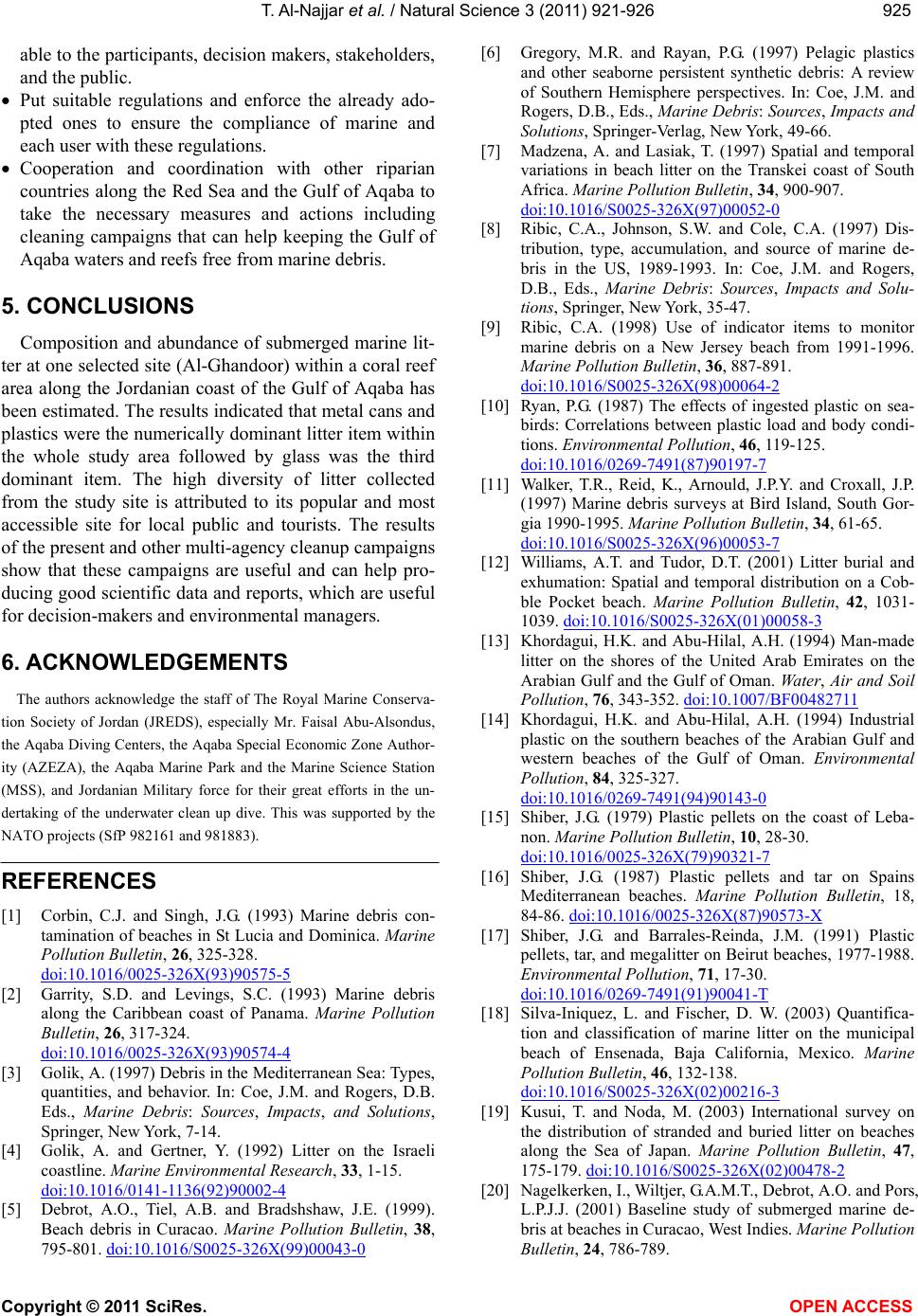
T. Al-Najjar et al. / Natural Science 3 (2011) 921-926
Copyright © 2011 SciRes. OPEN ACCESS
925925
able to the participants, decision makers, stakeholders,
and the public.
Put suitable regulations and enforce the already ado-
pted ones to ensure the compliance of marine and
each user with these regulations.
Cooperation and coordination with other riparian
countries along the Red Sea and the Gulf of Aqaba to
take the necessary measures and actions including
cleaning campaigns that can help keeping the Gulf of
Aqaba waters and reefs free from marine debris.
5. CONCLUSIONS
Composition and abundance of submerged marine lit-
ter at one selected site (Al-Ghandoor) within a coral reef
area along the Jordanian coast of the Gulf of Aqaba has
been estimated. The results indicated that metal cans and
plastics were the numerically dominant litter item within
the whole study area followed by glass was the third
dominant item. The high diversity of litter collected
from the study site is attributed to its popular and most
accessible site for local public and tourists. The results
of the present and other multi-agency cleanup campaigns
show that these campaigns are useful and can help pro-
ducing good scientific data and reports, which are useful
for decision-makers and environmental managers.
6. ACKNOWLEDGEMENTS
The authors acknowledge the staff of The Royal Marine Conserva-
tion Society of Jordan (JREDS), especially Mr. Faisal Abu-Alsondus,
the Aqaba Diving Centers, the Aqaba Special Economic Zone Author-
ity (AZEZA), the Aqaba Marine Park and the Marine Science Station
(MSS), and Jordanian Military force for their great efforts in the un-
dertaking of the underwater clean up dive. This was supported by the
NATO projects (SfP 982161 and 981883).
REFERENCES
[1] Corbin, C.J. and Singh, J.G. (1993) Marine debris con-
tamination of beaches in St Lucia and Dominica. Marine
Pollution Bulletin, 26, 325-328.
doi:10.1016/0025-326X(93)90575-5
[2] Garrity, S.D. and Levings, S.C. (1993) Marine debris
along the Caribbean coast of Panama. Marine Pollution
Bulletin, 26, 317-324.
doi:10.1016/0025-326X(93)90574-4
[3] Golik, A. (1997) Debris in the Mediterranean Sea: Types,
quantities, and behavior. In: Coe, J.M. and Rogers, D.B.
Eds., Marine Debris: Sources, Impacts, and Solutions,
Springer, New York, 7-14.
[4] Golik, A. and Gertner, Y. (1992) Litter on the Israeli
coastline. Marine Environmental Research, 33, 1-15.
doi:10.1016/0141-1136(92)90002-4
[5] Debrot, A.O., Tiel, A.B. and Bradshshaw, J.E. (1999).
Beach debris in Curacao. Marine Pollution Bulletin, 38,
795-801. doi:10.1016/S0025-326X(99)00043-0
[6] Gregory, M.R. and Rayan, P.G. (1997) Pelagic plastics
and other seaborne persistent synthetic debris: A review
of Southern Hemisphere perspectives. In: Coe, J.M. and
Rogers, D.B., Eds., Marine Debris: Sources, Impacts and
Solutions, Springer-Verlag, New York, 49-66.
[7] Madzena, A. and Lasiak, T. (1997) Spatial and temporal
variations in beach litter on the Transkei coast of South
Africa. Marine Pollution Bulletin, 34, 900-907.
doi:10.1016/S0025-326X(97)00052-0
[8] Ribic, C.A., Johnson, S.W. and Cole, C.A. (1997) Dis-
tribution, type, accumulation, and source of marine de-
bris in the US, 1989-1993. In: Coe, J.M. and Rogers,
D.B., Eds., Marine Debris: Sources, Impacts and Solu-
tions, Springer, New York, 35-47.
[9] Ribic, C.A. (1998) Use of indicator items to monitor
marine debris on a New Jersey beach from 1991-1996.
Marine Pollution Bulletin, 36, 887-891.
doi:10.1016/S0025-326X(98)00064-2
[10] Ryan, P.G. (1987) The effects of ingested plastic on sea-
birds: Correlations between plastic load and body condi-
tions. Environmental Pollution, 46, 119-125.
doi:10.1016/0269-7491(87)90197-7
[11] Walker, T.R., Reid, K., Arnould, J.P.Y. and Croxall, J.P.
(1997) Marine debris surveys at Bird Island, South Gor-
gia 1990-1995. Marine Pollution Bulletin, 34, 61-65.
doi:10.1016/S0025-326X(96)00053-7
[12] Williams, A.T. and Tudor, D.T. (2001) Litter burial and
exhumation: Spatial and temporal distribution on a Cob-
ble Pocket beach. Marine Pollution Bulletin, 42, 1031-
1039. doi:10.1016/S0025-326X(01)00058-3
[13] Khordagui, H.K. and Abu-Hilal, A.H. (1994) Man-made
litter on the shores of the United Arab Emirates on the
Arabian Gulf and the Gulf of Oman. Water, Air and Soil
Pollution, 76, 343-352. doi:10.1007/BF00482711
[14] Khordagui, H.K. and Abu-Hilal, A.H. (1994) Industrial
plastic on the southern beaches of the Arabian Gulf and
western beaches of the Gulf of Oman. Environmental
Pollution, 84, 325-327.
doi:10.1016/0269-7491(94)90143-0
[15] Shiber, J.G. (1979) Plastic pellets on the coast of Leba-
non. Marine Pollution Bulletin, 10, 28-30.
doi:10.1016/0025-326X(79)90321-7
[16] Shiber, J.G. (1987) Plastic pellets and tar on Spains
Mediterranean beaches. Marine Pollution Bulletin, 18,
84-86. doi:10.1016/0025-326X(87)90573-X
[17] Shiber, J.G. and Barrales-Reinda, J.M. (1991) Plastic
pellets, tar, and megalitter on Beirut beaches, 1977-1988.
Environmental Pollution, 71, 17-30.
doi:10.1016/0269-7491(91)90041-T
[18] Silva-Iniquez, L. and Fischer, D. W. (2003) Quantifica-
tion and classification of marine litter on the municipal
beach of Ensenada, Baja California, Mexico. Marine
Pollution Bulletin, 46, 132-138.
doi:10.1016/S0025-326X(02)00216-3
[19] Kusui, T. and Noda, M. (2003) International survey on
the distribution of stranded and buried litter on beaches
along the Sea of Japan. Marine Pollution Bulletin, 47,
175-179. doi:10.1016/S0025-326X(02)00478-2
[20] Nagelkerken, I., Wiltjer, G.A.M.T., Debrot, A.O. and Pors,
L.P.J.J. (2001) Baseline study of submerged marine de-
bris at beaches in Curacao, West Indies. Marine Pollution
Bulletin, 24, 786-789.